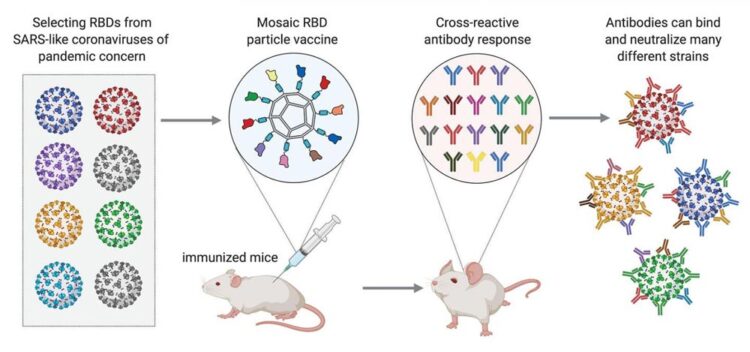The SARS-CoV-2 virus that is causing the COVID-19 pandemic is just one of many different viruses in the coronavirus family. Many of these are circulating in populations of animals like bats and have the potential to “jump” into the human population, just as SARS-CoV-2 did. Researchers in the laboratory of Pamela Björkman, the David Baltimore Professor of Biology and Bioengineering, are working on developing vaccines for a wide range of related coronaviruses, with the aim of preventing future pandemics.
Now, led by graduate student Alex Cohen, a Caltech team has designed a protein-based 60-subunit nanoparticle onto which pieces of up to eight different types of coronavirus have been attached. When injected into mice, this vaccine induces the production of antibodies that react to a variety of different coronaviruses–including similar viruses that were not presented on the nanoparticle.
The research is described in a paper in the journal Science.
This vaccine platform, called a mosaic nanoparticle, was developed initially by collaborators at the University of Oxford. The nanoparticle is shaped like a cage made up of 60 identical proteins, each of which has a small protein tag that functions like a piece of Velcro. Cohen and his team took fragments of the spike proteins of different coronaviruses (spike proteins play the biggest role in infection) and engineered each to have a protein tag that would bind to those on the cage–the other half of the piece of Velcro. When these viral pieces were mixed together with the nanoparticle cage structure, each virus tag stuck to a tag on the cage, resulting in a nanoparticle presenting spikes representing different coronavirus strains on its surface.
Displaying eight different coronavirus spike fragments (known as receptor binding domains or RBDs) with this particle platform generated a diverse antibody response, which is an advantage over traditional vaccine methods that present pieces from only a single type of virus. After inoculation, the antibodies subsequently produced by mice were able to react to many different strains of coronavirus. Importantly, the antibodies were reactive to related strains of coronavirus that were not present on the nanoparticle. This suggests that, by presenting the immune system with multiple different coronavirus variants, the immune system learns to recognize common features of coronaviruses and thus could potentially react to a newly emerging coronavirus–not just a SARS-CoV-2 variant–that might cause another pandemic.
Although the team is still studying the mechanism underlying this phenomenon, the results are promising. The next step is to examine whether immunization prevents viral infection and/or infection symptoms in animals making these antibodies.
“If we can show that the immune response induced by our nanoparticle technology indeed protects against illness resulting from infection, then we hope that we could move this technology forward into human clinical trials, though there are a lot of steps that need to happen between now and then,” says Cohen. “We don’t envision that this methodology would replace any existing vaccines, but it’s good to have many tools on hand when facing future emerging viral threats.”
“Unfortunately SARS-CoV-2 is unlikely to be the last coronavirus to cause a pandemic,” says Björkman. “Alex’s results show that it is possible to raise diverse neutralizing antibody responses, even against coronavirus strains that were not represented on the injected nanoparticle. So we are hopeful that this technology could be used to protect against future animal coronaviruses that cross into humans. In addition, the nanoparticles elicit neutralizing responses against SARS-CoV-2, so it could be possible to use them now to protect against COVID-19 as well as other coronaviruses with pandemic potential.”
###
The paper is titled “Mosaic nanoparticles elicit cross-reactive immune responses to zoonotic coronaviruses in mice.” Additional Caltech co-authors are research technicians Priyanthi Gnanapragasam, Yu Lee, Pauline Hoffman, and Leesa Kakutani; Susan Ou; research scientist Jennifer Keeffe (PhD ’09); senior research specialist Anthony West (PhD ’98); and senior postdoctoral scholar Christopher Barnes. Other co-authors include Hung-Jen Wu and Mark Howarth at the University of Oxford, and Michel Nussenzweig of The Rockefeller University. Funding was provided by the Caltech Merkin Institute for Translational Research, the National Institutes of Health, a George Mason University Fast Grant, and the Medical Research Council of the European & Developing Countries Clinical Trials Partnership program.

























